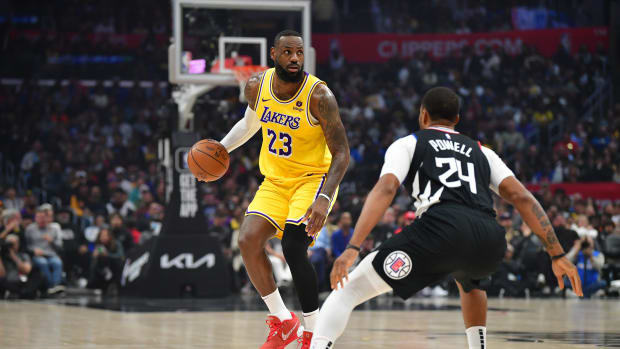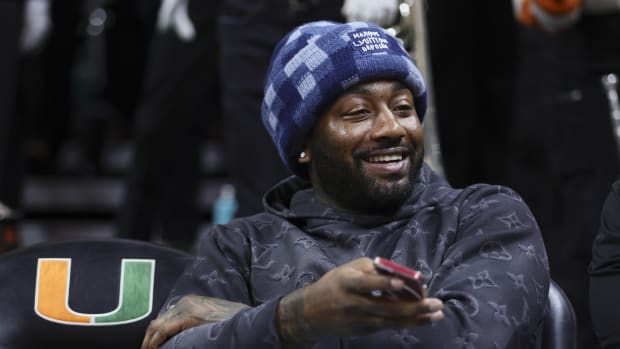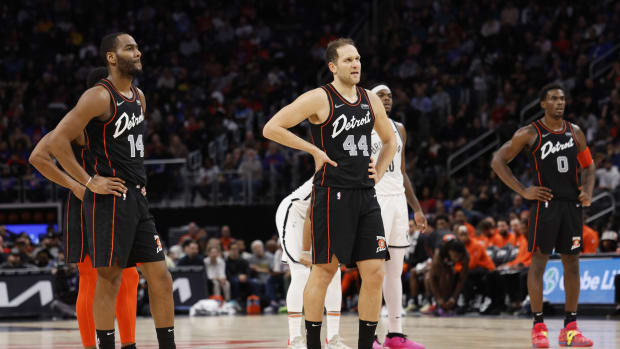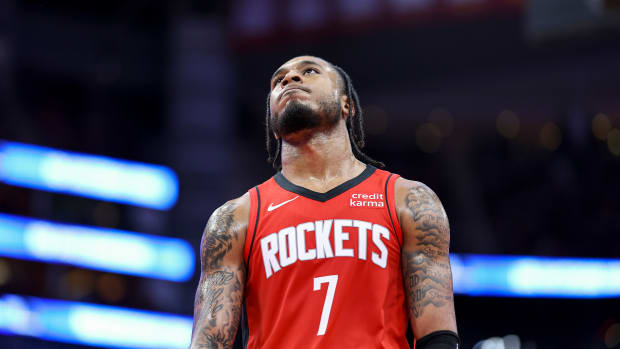Tinker Hatfield Q&A: The Nike Adapt BB and Life as a Futurist
BEAVERTON, Ore. — Tinker Hatfield is teeming with stories.
The legendary-doesn’t-even-do-him-justice shoe designer can talk for hours about numerous subjects, from Oregon’s natural beauty, to his sit-downs with Phil Knight or the time his wife accidentally sold a pair of rare Jordans at a garage sale. (“Thems the breaks,” she told her husband after selling a pair that were one of only a few in the world.) Hatfield, however, believes he tells his best tales through his shoes.
“I’ve often said, I’m a storyteller,” Hatfield explained to Sports Illustrated from a glowing room filled with shoes on Nike’s campus. “I happen to tell my stories through what I’m designing. So far, so good, I think.”
Hatfield spoke to SI after Nike revealed his latest project to hit the market—the Nike Adapt BB, shoes with self-lacing technology whose origins can be traced to the film Back to the Future. (As the story goes, it was Hatfield who suggested at the time shoes in 30 years would have power lacing.) Hatfield’s dream is now a reality. Back in November, he spoke to SI about seeing athletes wear the shoe, his role as a futurist and much more.
Rohan Nadkarni: What’s the most exciting part of this shoe actually becoming a reality?
Tinker Hatfield: Yeah, well, I’m excited about the introduction of this new technology into the real world of high-performance sports. We’re talking about the NBA. To see a new technology like this help the best athletes means it’s probably going to be pretty great for everybody else. There’s nothing like it before. Our goal is to do new, different and better if we can.
RN: So the obvious question now is, what would you say if someone asked you today what shoes will look like in another 30 years?
TH: Well, the question about being a futurist is really an important one. This project wouldn’t exist if I hadn’t been asked to think 30 years in the future. Power laces sort of made sense to me, so that’s what we embarked upon. What are we going to do next? Thirty years from now? We’re engaged in conversations all the time about what that’s going to look like. And, it would be a little bit tricky to tell you what we’re thinking about. That would be like telling the competition here’s what we’re going to do. But I think we’re on the very cusp of developing intelligent products that have this ability to adapt to the wearer, and we think that’s going to continue to evolve. Everybody knows about driverless cars. It’s all about artificial intelligence, adaptability. I think all those same things are going to happen here.
RN: If you asked me to sketch a shoe right now, I would do something completely unoriginal. When you’ve designed as many shoes as you’ve had, how do you come up with something new?
TH: I receive sketches from all ages now. It used to be just kids, but now those kids have grown up and they’re still sending me sketches. The reality is it’s really difficult to think up new stuff. It’s not just thinking up the future, it’s thinking about what might be available for us, and does it make sense. We spend a lot of time thinking about how people’s lives are going to change. That gives us a window of opportunity to make some design decisions. When I design—this is my standard thing I say—whatever I dream up is kind of a culmination of my life up to that point. Then you add in, and then there’s some guesswork.
Video: Nike Looks to the Future With Self-Lacing Basketball Shoe
RN: What motivates you to keep going after all the success?
TH: It’s a good question, it’s a universal question. Why do we keep doing what we’re doing? I would just simply respond by letting you know this is extremely fun stuff. When you get a chance to try on these powerlacing products, the look on your face, is very, very rewarding and very fun. We learn a lot from watching other people discover what we’ve been working on. Why would I not want to be doing that? It sounds to me like something as long as I can, I’ll keep working on it.
I’m also just trying to stay upright like most people my age. It’s a goal. I spent a lot of time strategizing with Mark Parker, who runs the whole shoot and works here. We both think we have unfinished business. So when you sort of back up a little bit and think about what you’re doing today and why, it comes from this desire to leave this place in a position of power and strength. That’s a good goal. That’s a good reason to keep working for a little while longer.
RN: How do you marry Nike’s interests as this performance company that wants to be on the cutting edge with your desire to be creative and tell stories?
TH: The question of technology vs. story and meaning is an interesting confluence. You can say my job description is to make the best products for the best athletes or any athlete in the world. I think of it a little bit differently. I think part of that is true. I think I’m here to also give them something fun. We’re trying to be enablers. We’re trying to enable people to participate in things they love to do. I see myself that way.
RN: In the 30-plus years you’ve been here, what are some of the most important things you’ve learned?
TH: The question of what you’ve learned over time is always a good one, not only to try to answer to others but to continually answer for yourself. And I will tell you, I think early in my career I felt like I was a one-man band. I was going to try to drive product through the process and make a big difference. What I’ve learned over all of these years is that I’m just part of an ecosystem. And an ecosystem all has to be healthy and work for any of us to be successful. And that’s a big mindshift for any young person. The ecosystem here is the athletes, it’s all of the other collaborators that help us design and engineer. The biggest and best role any of us can play is to help or enable people to be happy, healthy and relevant in their own lives. We just happen to have this great foundation of sports.
Phil Knight once told me, don’t ever retire. He went on to explain that if you don’t have a strong purpose in life you slow down. A personal goal for me is to stay young, stay relevant and stay healthy. At least in my mind. We all want that. And having a purpose bigger than my own goals, in other words trying to help other people, I think that’s a worthwhile pursuit. It’s just the right way to think about life.
RN: I know you don’t like to talk about it, but you have left a legacy here. What does that mean to you?
TH: Well, I certainly didn’t—some people set out in life to make a name for themselves. I didn’t come to Nike for that. I thought this could be a fun job where I could use what I learned in school. Sports was a passion of mine from an early age. I think it’s the horse and the cart. The horse is just getting educated, and developing an ability for problem-solving and having ideas that come from your experiences. That’s the horse. The cart is the company, the teams and the product that come back and support the ideas that you’ve been working with.
HARRIS: 2019 Sneaker Predictions: The Battle for Zion Williamson Begins
RN: In all your time doing this, have you ever had a moment in which you were overwhelmed or overcome with emotion?
TH: I’ve never been overwhelmed by the athletes. Famous athletes do the big product introductions and all the hoopla around that. I have been overwhelmed by the simple interactions with people who have been helped along the way. A good example would be getting a letter from [people] who’ve had numerous surgeries on their feet, and they haven’t been able to run, and they send you a note that says they could start running again because this shoe is so soft and comfortable. Those make me cry. It’s like, wow. Collectively, we’re improving people’s lives. That’s when I kind of lose it. In a good way.
RN: Do you have a next goal or next thing you want to accomplish?
TH: Part of my job over these years has been to be a futurist. You could say that’s been a relatively successful process. But I do think about my own role, and I think more and more as you gain experience and you see younger, talented people come up, you want to become a mentor. You want to become a teacher. And it’s a natural thing to then pay it forward and help other people do what you got to.
RN: Is there anything you’ve kept with you or keep with you every day to kind of remind you from where you started?
TH: That whole notion of nostalgia and looking back goes against my nature. That’s not unusual for people who are always trying to achieve something new and different. A good example would be that I used to try and get questions answered from like, Michael Jordan. Like, who is your favorite player of all time? Who inspired you when you were younger? And he doesn’t really have good answers, because he doesn’t really dwell on that stuff. It’s more like, where are you going now? Sometimes it’s helpful to try to remember something successful, that’s a good memory, and maybe you want to replicate it. But that’s really not how to operate in the future. You really have to keep flying ahead. The sports metaphor would be, if you look back in a race, it’s a bad move, because it’s going to slow you down. There’s a sports metaphor for you. I don’t even have a collection of shoes. I just have old ones scattered around the house. It’s more like, well, now what? Let’s go do something now.



































